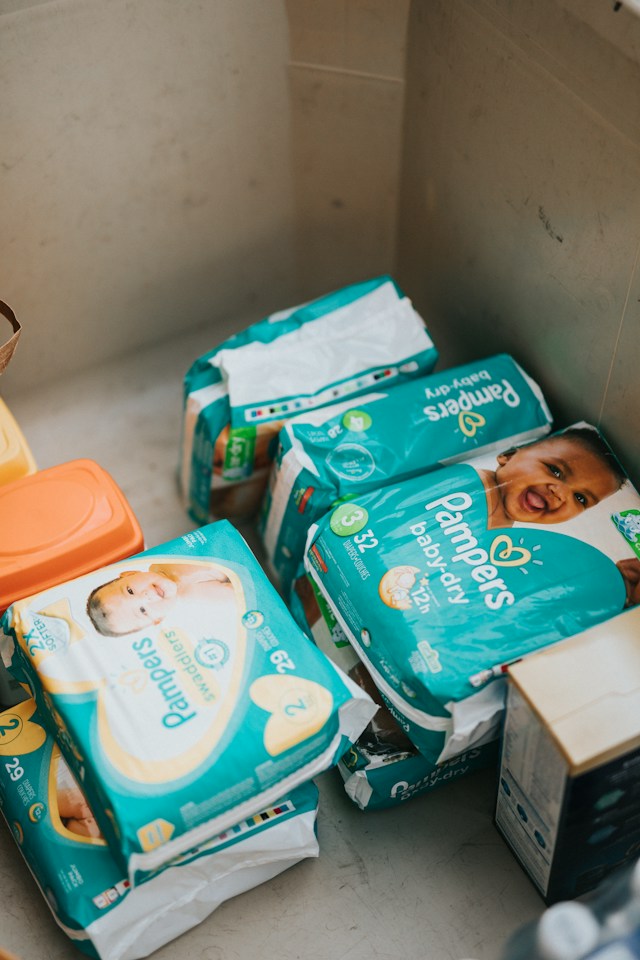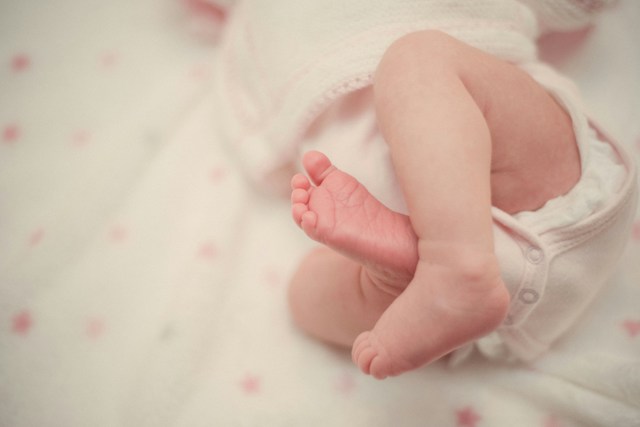The western world is falling behind.
Current statistics bemoan the literacy and numeracy rates of the younger generation.
But here’s something else to worry about. I’m going to call it potteracy rates. Yes, I’m making up that word but it pairs so nicely with literacy and numeracy. I’m referring to potty training in the western world.
We’re bad at it.
We used to be better.
In fact, what used to take less than a year, now routinely takes up to three years to achieve.
And, it turns out this downturn in achievement is creating a huge and lucrative market to exploit, not to mention environmental issues galore.
Ladies and gentlemen, I give you the diaper industrial complex.
… the diaper industrial complex.
The history of the diaper is surprising. Take a moment to appreciate that you weren’t born back in Siberia in the 1800s. Back then, infants’ hindquarters were packed in moss and wrapped in sealskin. Elsewhere in the world, things like milkweed leaves or animal skins were used for absorbency. Cloth diapers didn’t come on the scene until the 1500s. These early diapers weren’t washed but shaken out, dried and reapplied. As a mother who has changed several years worth of diapers, I have a hard time believing this … but there you have it.
The term diaper refers to the stitching that was routinely used on pieces of cloth to increase absorbency. The ‘dia’ part of the word diaper refers to the repeating pattern of stitching or weaving across the fabric, diagonally or otherwise.

By the 1800s, linen or flannel diapers started showing up on babies’ bottoms. Decades would pass without many improvements, but at least they’d figured out that washing those diapers might be a good idea.
The first major improvement on the diaper scene came in the 1920s with the introduction of rubber pants. In the 1950s, rubber morphed to plastic. Now, you could dandle a baby on your knee and not have to change your pants, as well as baby’s.
The evolution to a disposable diaper was a slow one, that, oddly enough, involved air travel. A few inventors had been toying with various designs for a disposable diaper but they weren’t commercially viable nor widely available. Passengers who travelled with babies on trans- Atlantic flights on Eastern Airlines, however, were in luck. Working with Chicopee Paper Mills, Eastern Airlines created a paper diaper that passengers could chuck when it had served its purpose. Their disposable diaper debuted in 1949 and they called it, fittingly, CHUX.
In 1961 Proctor and Gamble introduced Pampers, the brand that would come to dominate the disposable diaper market. They were invented by a grandfather while on holiday with his infant grandson, and as much as they were a game changer, they didn’t feature adhesive closures so parents had to travel with tape.

Due to the rise of working moms and other time crunches, the diaper of choice is now disposable. They come with a huge environmental cost but that’s a whole ‘nother subject. The social cost is what surprised me.
… the average infant goes through
more than 2,000 diapers in the first year of life.
The figures are wobbly, but the average infant goes through more than 2,000 diapers in the first year of life. A 120 count of newborn diapers retails for about $35. The price seems to stay the same right through to the Cruiser sizes but you get fewer diapers. Pull-ups can fit children up to 41 lbs. There’s a high cost associated with extending the toilet training process.

Now, back in the 1950s, North American rug rats were largely toilet trained by 15 to 18 months. Those wet diapers were a huge incentive but the ever-dry disposable diaper has removed that incentive. Pampers’ own site suggests that two years of age is an optimistic time to commence potty training but not to expect consistency until age 4. Elsewhere in the world, many parents rely upon something called ‘elimination communication’ wherein the parent pays attention to cues from the baby and the baby soon – long before the first birthday – comes to understand the use of a toilet. Brazil, Vietnam, the Philippines, China, much of Africa – this is the standard practice. The environmental benefits let alone the cost savings are obvious.
As always, there’s a high price for convenience.
This week’s question for readers:
WHAT ARE YOUR THOUGHTS ON DISPOSABLE DIAPERS?
Leave your Comments below!
Register for The Plain Jane newsletter and stay up to date with upcoming contests.
Submissions to last week’s question:
ARE YOU ROCKING GRANDPA CHIC? WHAT DRIVES YOUR DECOR?
The driving factor of my decor is what I would call “Found, Family or Free”. A tour of my early ‘70s sunken living room would include a ‘90s white leather sofa and love seat left behind by neighbours when they moved, a ‘40s torchiere floor lamp and round side table given to me by a former landlady, and a cedar chest purchased by my grandmother in 1933. Another side table of indeterminate age (early 2000s?) was a road-side find. Two second-hand cheetah-print occasional chairs bracket the rock-wall fireplace. Horribly eclectic, but somehow it all works – for me, anyway.
Sandi Bezanson-Chan
Refinishing mid century teak and maintaining my 56 year old example of rolling death – my 1968 Dodge Charger – confirm my Grandpa chicness.
Patrick Ramsay
If I had children, I would probably be a grandpa now. I was a typical bohemian in my teens in the 70’s. I stayed from house to houses and people came and went at mine. I inherited two of those stuffy rock solid sofa chairs from the 30’s or 40’s from some temporary “lodgers”. You know, those with carved velvet upholstery and wood decorations on the top of the arms. One of them had cigarette burns. I loved them to pieces. No matter what acrobatic acts you perform on them, they wouldn’t even squeak! But very sadly, when I decided to move to Toronto in 82, I was not able to take them with me and I sold them in a garage sale for $30 a piece. I still think about them.
Recently, a friend’s mother had to move into a care facility and I got her lovely wingback chair from the 1920’s. I took it to an upholsterer and he found enough vintage burgundy carved velvet to replace the 70’s upholstery. It is now my favourite piece of furniture. My husband and I do not get tired of admiring it.
Soon Loo
My ten year old granddaughter says my house is old fashioned. Her parents are minimalists.
The highlight of my decor is my eight foot long oak table with matching chairs. I give art classes at this table to friends and neighbours aged nine to eighty-six. Several years ago I painted some small cupboards white – Coastal Grandma Chic! These pieces are now a main feature in the decor of a local clothing and gift store
Joan Ellis
In 1965 I inherited, from a then boyfriend’s grandparents, a heavy oak framed overstuffed sofa, club and wing chair ensemble of unknown age. Over the next 59 years, it has been moved to and from four shared apartments and seven homes. Each move was accompanied with complaints and groans about the weight and appropriateness of the set, but I persisted. It is so comfortable, and with multiple changes of upholstery and slipcovers, has adapted to Wartime 1950, West Coast Modern, 1904 Heritage and now High Rise condo style homes. I have never wanted or shopped for a replacement. Along with my 1920’s era round oak dining table, sideboard and china cabinet (bought in 1970 for $125) I am very content with ‘Grandpa Chic’!
Diane Muir
You always hit the nail on the head! I love your ‘Grandpa Chic’ article – oh, to see those lovely heirlooms appreciated again! I work in an industry where we value these precious things. We are the custodians and we love to find them new homes where they will be treasured and enjoyed to pass on to further generations.
Jeanette Langmann
Grandpa chic, indeed! I have never been able to put a label on my style (nor do I want to) other than inherited or recycled hand-me-downs, travel related treasures and what have you. Somewhat eclectic, to say the least. In 40 plus years I have only purchased one new piece of furniture – an off-white loveseat which I still have (no kids so it still looks good). My furnishings and decor tell a multitude of stories. My grandparents’ blanket box; the carpet I hauled back from India along with a opium bowl; pottery from northern Peru; burl tables my dad made, afghans and needlework from my mom’s hands, mismatched side tables and dining room chairs; varied collections, (did I mention my sheep?), baskets from the Amazon and Saskatchewan … and yes, one basket to hold my knitting. I don’t want new, trendy stuff. I want my surroundings to talk to me, to have a history. To top it off, I’ve just purchased a new recliner. Comfort is all part of my style!
Sharon Tokar
In the 1980s we had the good fortune to be building a cabin at Whistler at the same time that our senior relatives were downsizing. My husband’s uncle lent us his mother’s dining room table which he had stored in his basement in the ‘60s. A set of bunk beds came from my Aunt’s, along with two wooden cutting boards shaped like pigs which we have hanging above the stove. But the best hand-me-down (now grandpa chic) are our living room sofas. I have paid to have them recovered because they are the best sofas for napping. The armrests are low and wide, probably approaching a foot. My feet rest on one and my head with a pillow on the other while my book rests on my gently rising abdomen.
Margot Brown
I was destined to be Grandma Chic in my later life. Why? Because I grew up in a house full of my late grandmother’s mahogany furniture and collectibles, most having been shipped across the Atlantic when she moved to Canada to marry her homesteading husband-to-be around 1910. Reminders of my late grandmother’s British heritage were everywhere – on the mantle and every table top, inside china cabinets and tucked into every last nook and cranny. As my parents passed, some of Grandma’s stuff moved into my home. Starting over with “new” became a more fleeting thought as time passed. Now I’ve added to Grandma’s collection. My 77 year-old wooden toddler’s rocking chair sits casually by the fireplace.
Susan Hope
Back in 1952, dad bought a beautiful, dark oak, very heavy sideboard to go into our new home they had built in Victoria. I was 12!! Much excitement! The sideboard travelled with them to North Van in 1962, the West End in 1964, East Richmond in 1970, and nestled into their new townhouse in Central Richmond about 1984. While reading your lovely article last Saturday our son delivered the beautiful Grandpa (and Grandma) Chic sideboard to stay in our home in Steveston. It is a treasure and will be in our family forever!
Judy Assoon
